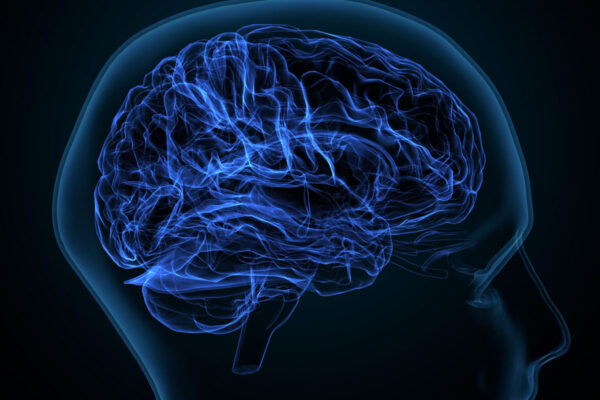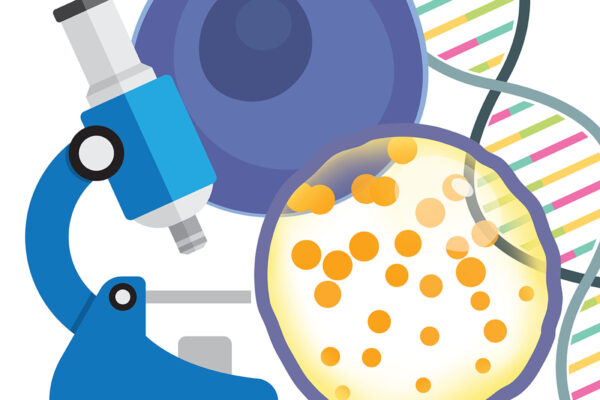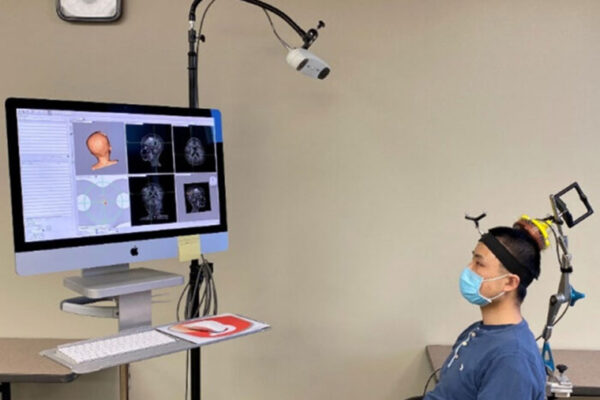(Video: Huy Mach/School of Medicine)
Dozens of noted scientists, philanthropists, and university, state and local leaders gathered Jan. 18 to celebrate the dedication of one of the world’s largest neuroscience research buildings, a gleaming state-of-the-art facility on the Washington University Medical Campus.
They toured its sophisticated, newly christened labs; listened intently as Washington University scientists described the lifesaving work they aim to accomplish there; and absorbed inspirational words detailing the people, history and hopes behind the massive 609,000-square-foot, 11-story building.
“I see this building as the ultimate statement of our school, our university, our city, our state — that here in this place, in St. Louis, at the Gateway to the West, the most important advances in understanding the brain will happen,” David H. Perlmutter, MD, the George and Carol Bauer Dean of Washington University School of Medicine, told the gathering.
Those attending also celebrated the glistening structure’s brand-new name: the Jeffrey T. Fort Neuroscience Research Building, in recognition of a generous gift from Fort, a longtime supporter of the university. The name was a surprise announcement at the event, as was news of the building’s freshly titled McDonnell Lobby, following a gift from James and Elizabeth McDonnell. Members of the Fort and McDonnell families were present for the dedication. Chancellor Andrew D. Martin announced the gifts and thanked the families for their profound, ongoing support.
“We could not have attempted such a project without extraordinary help,” Martin said.

“As we dedicate this building, we stand on the threshold of a new era for medical science and a new era of catalytic impact for WashU Medicine,” the chancellor said. “The research conducted in this building will help the patients we serve and will unlock principles fundamental to the workings of the nervous system. Our understanding of those principles will lead to new therapies, new diagnostic tools and new drugs that can improve the lives of people around the globe.
“WashU’s reputation for excellence in neuroscience is already well known, but this building and the research that we will conduct here will mobilize our expertise in ways never before seen, making discoveries at the frontier of brain science to alleviate suffering and cure diseases once seen as incurable and intractable.”
To read more about neurosciences and the new building at Washington University, read our extensive coverage in Outlook magazine.
Some of those gathered for the dedication have had personal experience with diseases of the brain and the suffering they cause.
Among them was Fort and his sister, Liz Dorr, the latter of whom expressed gratitude at the gathering for the Washington University physicians who had helped her brother through two major medical challenges — one involving his eyesight, and the second involving a rare, life-threatening condition that caused bleeding in his brain. Addressing Fort directly during her remarks, Dorr said that their mother, who died 6½ years ago, would be extremely proud of him for his contributions to the school, and congratulated the university community on its new, deeply meaningful building.
“What a gift to St. Louis, as it represents hope to so many families,” she said.

Perlmutter also noted his own family’s experience. “Nothing has been more heartbreaking for me and my sisters than watching the effects of neurodegeneration on our mother,” shared the dean, who is also executive vice chancellor for medical affairs and the Spencer T. and Ann W. Olin Distinguished Professor.
“This is a common story that I know many of you have experienced, and mine is far from the most tragic. Each of you has a story of a once-vibrant person in your life or has experienced a loved one struggle with addiction or depression or commit suicide,” Perlmutter continued. “For most of human history these experiences have been problems without solutions and some without even a name, and they continue to have a devastating ripple effect on all of us. Solving these problems, as we must, takes the sharpest of minds, significant resources, and creative strategies to promote collaboration, and that is precisely what this incredible new building is about.”
The university invested $616 million to construct the building and broke ground in March 2020, just as the COVID-19 pandemic took hold. It sits at 4370 Duncan Ave., on the eastern edge of the Medical Campus and in the 200-acre Cortex Innovation District, a nationally recognized innovation and technology hub that also is home to a number of biotech startups founded by Washington University faculty. Investment in the neuroscience research building was spurred by the expectation that it will become one of the nation’s premier neuroscience research hubs and that situating it in Cortex will create synergy with the many entrepreneurs and startup companies there, helping to commercialize Washington University discoveries.
“This building will not just change the way WashU does neuroscience; we expect it to radically change the trajectory of neuroscience research and its impact,” Andrew M. Bursky, chair of the university’s Board of Trustees, told those gathered at the dedication. “We have made this investment in scientific infrastructure, because we believe that it is critical to solving some of the most urgent problems of human health and longevity.”
The building was specifically designed to foster collaboration. Scientists from some 120 research teams that previously were located in 16 different locations on the Medical Campus now work in the same building, uniting experts in neurology, neuroscience, neurosurgery, psychiatry, anesthesiology, radiology, genetics and developmental biology. The building is organized by research themes, including brain tumor biology, psychiatric illness, pain, and neurodegenerative diseases such as Alzheimer’s, Parkinson’s and Huntington’s diseases, as well as amyotrophic lateral sclerosis (ALS).

“Choosing to pursue my PhD at Washington University has been one of the wisest decisions I have made thus far in my academic career,” said Kia Barclay, a Washington University PhD student studying neuroscience. “I have learned that successful mentorship can be fostered in manners we least expect, and meaningful scientific advancements can be inspired by people with whom we never thought we would interact. While I was initially overwhelmed by the thought of relocating lab space in the middle of my training, moving to the neuroscience research building has made these organic and unexpected interactions a regular occurrence.”
Bhooma Aravamuthan, MD, DPhil, an assistant professor of neurology and of pediatrics, said the building is a draw for early-career scientists such as herself.
“The new building provides a serendipity of geography, meaning it makes it easier to walk to another researcher’s office to ask for advice or to talk with another researcher about collaborating,” said Aravamuthan, whose research focus is on pediatric movement disorders. “The medical school already has a strong, supportive community, but the building makes it even more so.”
Translating the findings that stem from such collaborations not only will culminate in real-life clinical applications, Bursky explained, but will help St. Louis’ future economic health, too. “Developing commercially viable therapeutics and technologies will play a key role in regional growth,” he said.

Bursky invited Missouri Gov. Mike Parson, who spoke at the dedication, to feel free to use the neuroscience research building as a source of “bragging rights” at the next meeting of the National Governors Association.
“I will,” Parson responded when his turn at the podium came. “Make no mistake about it.”
Any such boasting appears likely to extend beyond governors’ meetings. Parson spoke of his travels overseas to boost Missouri’s profile to benefit the state.
“I try to get people to come here, whether it be (for) research, whether it be businesses, whether it be technology,” he said. “We’re going to have the world’s best in St. Louis, Missouri, doing research at Washington University. I tell you, that is a recruiting tool that is a blessing for this entire state. … And when you think of all the good things that are going on in St. Louis and this region, in almost every aspect, we should all be very proud to be here today at this moment for what we’re doing, because we’re now going to lead the world in neuroscience research.”
Perlmutter said he refers to the School of Medicine as “one mission, one team — brilliant people, purpose-driven, working together on what I have called the virtuous cycle of academic medicine … that virtuous cycle in which we provide the best possible medical care for today while at the same time relentlessly pursuing improvements through the best possible research investments, through the best possible education and training programs.
“These are our expressions of the belief that science can produce lasting improvements in promoting the health of our community,” he explained. “And this building is a testament to our belief in that cycle and in our team and in our mission.”

Senior medical sciences writer Kristina Sauerwein contributed to this story.
Originally published on the School of Medicine website.


